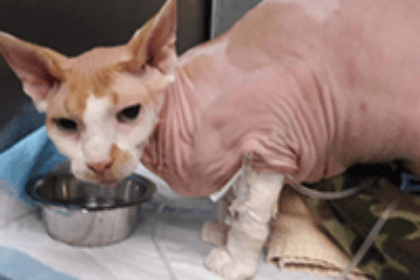By Dr. Melissa Conrad
Osiris, a 3 year old Sphynx (an exotic hairless cat), was presented to Mill Creek Animal Clinic for not feeling well for a couple days. Osiris had several episodes of vomiting over the past weekend with small pieces of cloth appreciated within the vomit. Mom had been working on her Halloween costume (yes, there are people in the world who can still sew), and she thought the material looked like he had gotten into her supplies. Osiris, while a very good boy, did have a bad habit of eating things he shouldn’t. Osirus was acting tired at home and was unwilling to drink water.On physical exam it quickly became evident that Osiris was deteriorating quickly and emergency medical intervention was initiated. He was severely dehydrated and his blood sugar was very low. An intravenous (IV) catheter was placed and Osiris was given fluids supplemented with dextrose to help increase his blood sugar. We also started warming measures to help Osiris regulate his body temperature. With his IV fluids and warming blanket, Osiris started to perk up a little bit while he was in hospital.

Although Osiris was pretty out of it, we could tell he was very painful on abdominal palpation (feeling around his belly) and since he had a history of eating foreign objects, we elected to proceed with an abdominal ultrasound. An ultrasound is an imaging technique that uses sound waves to allow us to see the internal organs as well as look inside the gastrointestinal (GI) tract. Since Osiris’s condition was so guarded, we did not want to pursue surgical intervention unless we were sure of what was happening. Osiris’s ultrasound revealed that he had a large amount of foreign material in his small intestine that was causing an obstruction. Osiris’s foreign body was especially dangerous in that it was a linear foreign body. A linear foreign body is usually a long piece of cloth-like material that gets stuck in the intestinal tract. As the intestines try to push the string-like material through, the intestines become bunched on one another and the foreign body actually starts to cut through the intestinal wall.Given this ultrasound finding, we had no choice but to take Osiris into surgery to remove the foreign body from his intestinal tract. Ideally we would have liked Osiris’s condition to be more stable before such a big surgery, but to wait would mean increasing chances of septic peritonitis, and if this happened, we would lose him for sure. During surgery, a large amount of foreign material was felt in the beginning of the small intestines. Three enterotomies (incisions into the GI tract) were made to remove about 1.5 feet of a black cloth material. We had to enter the intestine, cut the piece of material and pull out a section only if it came easily. It was important not to pull, since this could cut through the intestine like a knife. Osiris made it through surgery despite his blood sugar and body temperature continuing to fluctuate.Since Osiris was so sick, he was transferred to a 24 hour emergency hospital for continued care overnight. Osiris stayed at the emergency care center for several days on IV fluids with glucose support, IV antibiotics and pain medications. Once his blood sugar stabilized and he was re-hydrated, Osiris was discharged to be supervised under the watchful eye of his loving family.
With any surgery where you have to cut into the intestinal tract, there is always concern that the intestines can dehisce (start to leak) following the surgical correction. Even if the initial surgery goes well, it is crucial to monitor the patient closely for the 3-5 days after surgery. Luckily, Osiris’s intestinal sites healed appropriately with no leakage.Osiris continued to improve following surgery and he now remains at home with his family. We saw the handsome guy for his suture removal and he is back to his loving, energetic behavior! Overall, we couldn’t be happier with the amazing progress this patient has made!
What's Next
Call us or schedule an appointment online.
Meet with a doctor for an initial exam.
Put a plan together for your pet.


